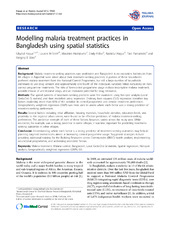| dc.description.abstract | Background: Malaria treatment-seeking practices vary worldwide and Bangladesh is no exception. Individuals from 88 villages in Rajasthali were asked about their treatment-seeking practices. A portion of these households preferred malaria treatment from the National Control Programme, but still a large number of households continued to use drug vendors and approximately one fourth of the individuals surveyed relied exclusively on noncontrol programme treatments. The risks of low-control programme usage include incomplete malaria treatment, possible misuse of anti-malarial drugs, and an increased potential for drug resistance. Methods: The spatial patterns of treatment-seeking practices were first examined using hot-spot analysis (Local Getis-Ord Gi statistic) and then modelled using regression. Ordinary least squares (OLS) regression identified key factors explaining more than 80% of the variation in control programme and vendor treatment preferences. Geographically weighted regression (GWR) was then used to assess where each factor was a strong predictor of treatment-seeking preferences. Results: Several factors including tribal affiliation, housing materials, household densities, education levels, and proximity to the regional urban centre, were found to be effective predictors of malaria treatment-seeking preferences. The predictive strength of each of these factors, however, varied across the study area. While education, for example, was a strong predictor in some villages, it was less important for predicting treatmentseeking outcomes in other villages. Conclusion: Understanding where each factor is a strong predictor of treatment-seeking outcomes may help in planning targeted interventions aimed at increasing control programme usage. Suggested strategies include providing additional training for the Building Resources across Communities (BRAC) health workers, implementing educational programmes, and addressing economic factors. | en_US |

